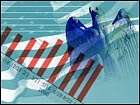|
Fed: U.S. economy still weak
|
 |
November 28, 2001: 4:19 p.m. ET
Beige Book report sees some signs of hope, but mostly weakness.
|
NEW YORK (CNN/Money) - The Federal Reserve saw continuing weakness in the U.S. economy in October and early November, according to its periodic Beige Book report, released Wednesday.
The survey, named for the color of its cover, is a compilation of reports about economic activity in each of the 12 Fed districts throughout the country.
"Reports from the Federal Reserve districts indicate that economic activity generally remained soft in October and the first half of November," the report said.
Dragging the economy down were a continuing slowdown in manufacturing activity and a worsening labor market. Propping it up were strong sales for automakers and discount retailers and a stable residential real estate market.
"Unsurprisingly, the new Beige Book retains the overall gloomy tone, but it also acknowledges that some sectors are not doing as badly as others," said Ian Shepherdson, chief U.S. economist at High Frequency Economics Ltd.
The most important aspect of the economy, consumer spending, which makes up two-thirds of the U.S. gross domestic product (GDP), the broadest measure of economic activity, sent mixed signals.
The good news was that consumers were willing to take advantage of zero- and low-interest financing for cars and trucks and generous discounts by some retailers.
The bad news was that many auto dealers fear their sales will disappear once their incentives are withdrawn, few consumers were splurging on big-ticket items and the tourism industry continued to suffer after the Sept. 11 terror attacks.
"Consumer spending, while strengthening slightly in October and the first half of November, remained at or below pre-Sept. 11 levels in most districts," the Fed's report said.
Click here for CNNmoney.com's economic calendar
In an effort to keep consumers spending and avert a recession, the Fed has cut its target for short-term interest rates a record-tying 10 times this year, to a 40-year low of 2.0 percent.
Economists are divided about whether or not the Fed will cut again after its next policy meeting, scheduled for Dec. 11, but members of the policy committee have recently indicated they favor a continued aggressive stance by the Fed.
A recession is commonly defined as two consecutive quarters of shrinking GDP. It shrank in the third quarter and is widely expected to do worse in the fourth quarter.
And, the National Bureau of Economic Research, a panel of economists that uses different criteria to mark the beginning and end of economic recessions and expansions, said Monday that it thought a recession began in March.
Before Sept. 11, most of the economic slump was a result of a slowdown in business spending, which caused manufacturers to dramatically cut production, leading to a recession in the manufacturing industry lasting more than a year.
Manufacturing continued to suffer in October and early November, the Fed said, though many businesses were beginning to "hold the line" on spending rather than cut it further. Manufacturers were also working off their excess inventories of unsold goods, meaning they could start producing new goods again in the near future.
Most economists expect the economy to recover sometime next year. 
|
|
|
|
|
|

|

